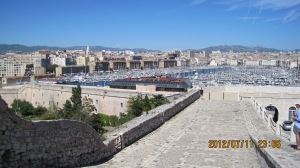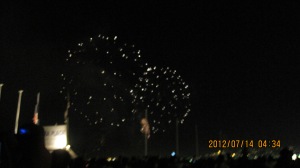A Quick Look at Marseille and Zurich
After our weekend visit to Bern, our group visited two more cities, Marseille and Zurich, as well as taking an impromptu trip to Nice. On Thursday morning we all loaded into an extremely hot and cramped bus/small van type vehicle to make the 6-hour trip to Marseille. Upon arriving in Marseille, I immediately noticed the differences between Marseille and Bern. Marseille identifies more with an American city like New York; it is bustling with cars and people, and dirtier and smellier than the pristine Swiss capital of Bern, although its port area sets it apart. It was also evident just from observing the people on the streets that Marseille was much more ethnically/racially diverse than other cities. We had learned about this in several readings with Professor Hyra that gave demographics and historical facts about the diversity found in Marseille. These readings, among other things, talked about how the multiculturalism in Marseille may have been one of the factors that kept Marseille from rioting, like Paris did in 2005. Unlike Paris and other French cities, Marseille has its working class people, public housing projects, and ghettos in the inner city area, not the outer suburbs. They are included in the city structure. We learned about this unique city structure in the readings in class, and it was further magnified as we walked to our hostel, which was in an “interesting” part of town. Our hostel was located about a 15-minute walk from the port area, where most of the shopping and restaurants are, and through some windy side streets filled with trash and some strange smells. While it was not exactly a pleasant place to stay, it did really show us the real inner-city part of Marseille, the part that is not wrapped up in redevelopment.
Other readings that Professor Hyra gave us talked about the Euro Mediterranean redevelopment project going on in Marseille. It was portrayed in the readings (to me) as a glorified sort of port redevelopment that would benefit Marseille in many ways. Although we visited the city in the middle of the project, so there was lots of construction, the redevelopment part we did see (such as the revamped docks) were very empty and almost seemed to not even belong to the same bustling city that was a 15 minute walk away. After spending the weekend in Marseille, it was clear to me that there was a stark contrast between the theoretical Marseille I had in my mind, and what the city was actually like on the ground. There were many highlights to our trip though, including a dinner at a place right on the port, and a trip to the island of Frioul, with a Mediterranean beach and views for miles. Leaving Marseille there was one small blip in our plan; our train home left early and therefore our entire group, all 14 of us, missed our train. This resulted in us taking a train to Nice for the night, enjoying the Bastille day fireworks, and then catching an early train from Nice back to Riva about 12 hours late. I don’t think anyone in our group complained too much about this mistake.
On Tuesday we all successfully boarded a morning train to go to Zurich for the day. Some of our readings with Professor Dukes, who met up with us in Marseille, focused on community participation, as well as the activities in class that helped us understand how to have dialogue on important issues, rather than debate. To put these concepts into practice we listened to a presentation from Sigrun Rhode speaking about different examples of community participation that she had worked on in Zurich, including developing urban gardening and farming spaces in the city that would be available to everyone. Her presentation on organizing community participation and taking everyone’s concerns into account when developing new areas in the city made it seem although it was an easy and painless process. However, even just from the discussions that we have had in class where there are minor disagreements, I know that community participation is often not as cut and dry as it seems. It is often difficult to combine the interests of a population with the policies and regulations of a government, and the end goals of the two groups are often at odds. The readings highlight one of the most important thing you can do for this type of participation is to try to engage as many people as possible and engage them as deeply as possible, which is was obvious that Sigrun Rhode and her office attempt to do.
These two trips have brought us to the end of our study abroad program here in Riva. My blog only covers a few main trips and a few of the things I have learned on this program. This was my first time being abroad without my parents, and my first time actually living anywhere for longer than 5 days outside the US. The experience, as almost every single student who studies abroad says, was eye-opening and amazing. I’m considering attempting to convince my parents to let me study abroad for a whole semester this upcoming year: so with any luck, maybe I will return to Switzerland in the near future!
- Posted in: 2012 Summer Course

